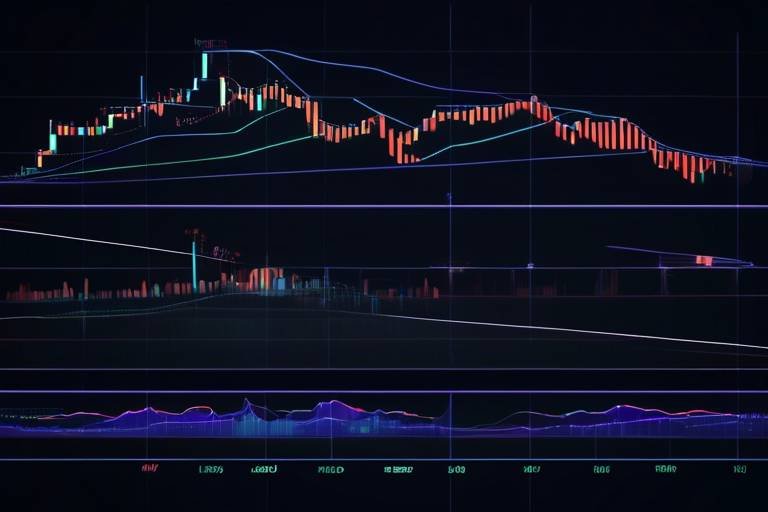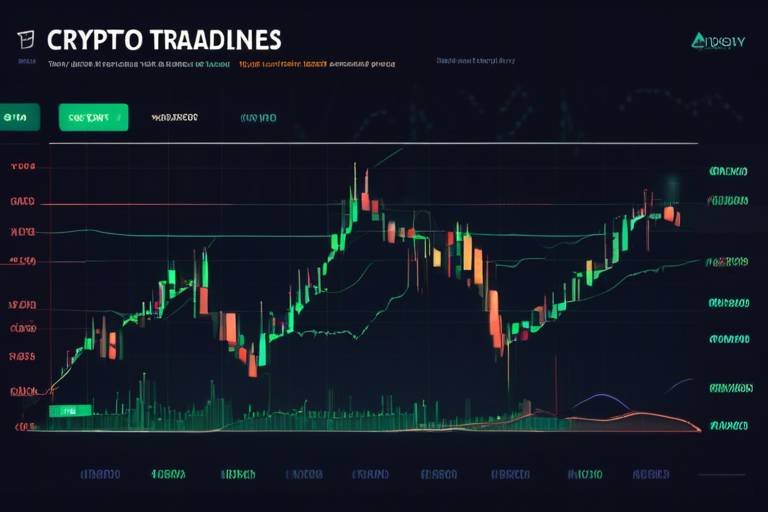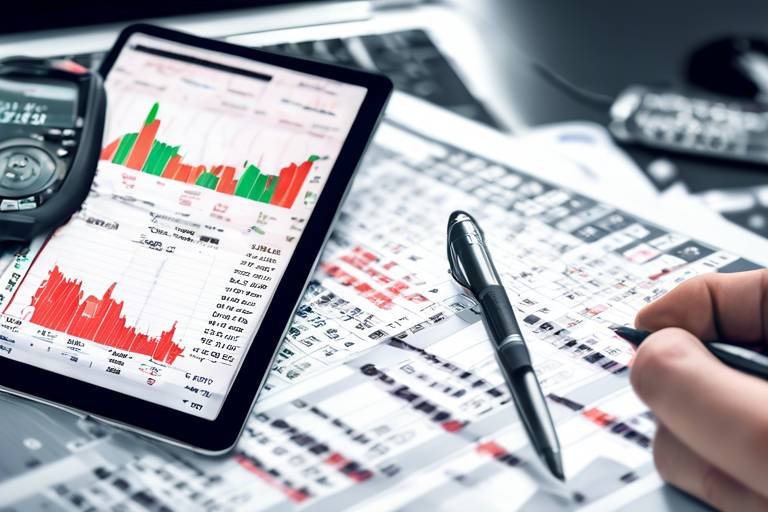How to Spot Opportunities Using Technical Analysis
In the fast-paced world of trading, technical analysis serves as a crucial compass, guiding traders through the unpredictable waters of the financial markets. But what exactly is technical analysis, and how can it help you spot lucrative opportunities? This article dives deep into the fundamentals of technical analysis, revealing key strategies and tools that can empower traders to identify potential market opportunities effectively.
At its core, technical analysis revolves around the examination of price movements and trading volumes. By analyzing historical data, traders can forecast future market behavior, making informed decisions that can significantly impact their trading success. Imagine trying to navigate a ship through a dense fog; without the right tools and knowledge, you're bound to hit a rock or two. Similarly, using technical analysis equips you with the insights needed to avoid pitfalls and seize opportunities.
Why is technical analysis so important? Well, it allows traders to understand market sentiment, identify trends, and make predictions based on statistical data rather than mere speculation. This methodical approach can be the difference between a successful trade and a costly mistake. As we delve deeper into this article, you'll discover the essential tools and techniques that can transform your trading strategy.
As we embark on this journey to uncover the secrets of technical analysis, keep in mind that the goal is not just to learn but to apply this knowledge practically. Whether you're a seasoned trader or just starting, understanding how to read charts, interpret indicators, and recognize patterns will empower you to make smarter trading decisions. So, let’s get started!
Technical analysis involves evaluating price movements and trading volumes to forecast future market behavior. It’s like deciphering a secret code that the market is trying to communicate. By focusing on historical price data rather than the underlying fundamentals of a stock or asset, traders can uncover trends and patterns that repeat over time. This approach is particularly useful in volatile markets where prices can swing dramatically.
The importance of technical analysis cannot be overstated. It enables traders to make decisions based on data rather than emotions, which can often lead to irrational choices. Imagine you’re at a carnival, and the roller coaster looks terrifying. If you let fear dictate your actions, you might miss out on an exhilarating ride. Similarly, technical analysis helps you to stay grounded, allowing you to take calculated risks based on objective information.
To effectively perform technical analysis, traders rely on various tools that assist in interpreting price data. These include charts, indicators, and patterns. Each tool offers unique insights that can help traders identify potential opportunities in the market. Let’s explore some of the essential tools and how to utilize them effectively.
Charts are the backbone of technical analysis, visually representing price data over time. They allow traders to spot trends and patterns at a glance. There are several types of charts, each serving different purposes:
- Line Charts: These provide a simplified view of price movements over time, making them useful for identifying trends quickly.
- Bar Charts: These offer more detail than line charts, showing the open, high, low, and close prices for a specific time period.
- Candlestick Charts: These are popular among traders for their ability to convey a wealth of information in a compact format.
Line charts are perhaps the most straightforward type of chart, providing a clear visual representation of price movements over time. They connect closing prices with a continuous line, making it easy to spot trends. However, while they excel in simplicity, line charts do have limitations, such as lacking detailed information about price fluctuations within a given period.
Candlestick charts take visualization a step further by providing detailed information about price movements, including opening, closing, high, and low prices. Reading candlestick patterns can reveal market sentiment and potential reversals. For instance, a series of bullish candlesticks may indicate strong buying pressure, while bearish candlesticks could suggest selling pressure.
Technical indicators are mathematical calculations based on price and volume data that help traders make informed decisions. Some popular indicators include:
- Moving Averages: These smooth out price data to identify trends over a specific period.
- Relative Strength Index (RSI): This measures the speed and change of price movements, helping traders identify overbought or oversold conditions.
Recognizing trends and patterns is crucial in technical analysis. By identifying whether a market is trending upwards (bullish) or downwards (bearish), traders can align their strategies accordingly. Common chart patterns, such as head and shoulders or double tops, can signal potential market reversals or continuations, providing traders with valuable insights.
Support and resistance levels are fundamental concepts in technical analysis. Support refers to a price level where buying interest is strong enough to overcome selling pressure, while resistance is where selling pressure prevails. Identifying these levels can help traders make informed decisions about when to enter or exit trades.
Chart patterns, such as head and shoulders or double tops, signal potential market reversals or continuations. Recognizing these patterns can provide traders with a competitive edge, allowing them to capitalize on market movements. For example, a head and shoulders pattern might suggest a reversal of an upward trend, prompting traders to consider selling.
Effective risk management is essential for successful trading. Understanding how to manage risks while utilizing technical analysis to spot opportunities can be a game-changer. Strategies such as setting stop-loss orders and position sizing techniques play a vital role in mitigating potential losses.
Stop-loss orders are a trader's safety net, helping to limit potential losses by automatically closing trades at predetermined levels. By setting effective stop-loss orders based on technical analysis, traders can protect their capital while allowing for potential gains. It’s like having a life jacket while navigating turbulent waters; it keeps you afloat when things get rough.
Position sizing determines the amount of capital to risk on a trade. By calculating position sizes based on individual risk tolerance and market conditions, traders can ensure that they are not overexposed to any single trade. This technique is crucial for maintaining a balanced trading portfolio and minimizing risks.
Q: What is technical analysis?
A: Technical analysis is the study of past price movements and trading volumes to forecast future market behavior.
Q: How can I start using technical analysis?
A: Begin by learning about different chart types, indicators, and patterns, and practice analyzing historical data.
Q: Why is risk management important in trading?
A: Risk management helps protect your capital and ensures long-term trading success by minimizing potential losses.

Understanding Technical Analysis
Technical analysis is like the art of reading between the lines in the world of trading. Instead of relying on gut feelings or economic reports, traders use technical analysis to evaluate price movements and trading volumes. Imagine you're trying to predict the weather; you wouldn't just look out the window, right? You'd check the forecasts, charts, and historical data. Similarly, technical analysis provides traders with a set of tools to forecast future market behavior based on past price action.
At its core, technical analysis is built on the premise that all information is reflected in the price. This means that the market price is a culmination of all the information available at any given time. Traders believe that by studying price movements, they can identify patterns and trends that may indicate future price changes. It’s like being a detective, piecing together clues to solve a mystery. The beauty of this approach lies in its ability to apply to any market, whether it’s stocks, forex, or cryptocurrencies.
Understanding the principles of technical analysis is crucial for any trader looking to navigate the markets effectively. Here are some key principles that underscore its importance:
- Market Discounts Everything: All available information, whether it’s economic data or company news, is already reflected in the price. This means traders don’t need to worry about external factors; they just need to focus on the price movements.
- Price Moves in Trends: Prices tend to move in trends, whether upward, downward, or sideways. Recognizing these trends can help traders make informed decisions about when to enter or exit a trade.
- History Tends to Repeat Itself: Many traders believe that market psychology remains relatively constant over time. This means that patterns observed in the past are likely to recur, allowing traders to anticipate future movements.
The significance of technical analysis cannot be overstated. It provides traders with a framework to make decisions based on data rather than emotions. This systematic approach can help traders avoid the pitfalls of fear and greed, which often lead to poor trading decisions. By using technical analysis, traders can identify potential opportunities and manage risks more effectively.
In conclusion, technical analysis is an essential tool for traders looking to understand market dynamics. By evaluating price movements and trading volumes, traders can make informed decisions that enhance their chances of success. Whether you're a seasoned trader or just starting, grasping the fundamentals of technical analysis is key to spotting opportunities in the ever-evolving market landscape.

Key Tools for Technical Analysis
When it comes to navigating the bustling world of trading, having the right tools at your disposal is akin to a sailor having a well-equipped ship. Technical analysis is no different; it thrives on a variety of tools that help traders make sense of price movements and volume data. Understanding these tools is crucial for anyone looking to identify potential market opportunities effectively. So, what are these essential tools? Let’s dive into the essentials!
First on the list are charts. These visual representations of price data over time are the backbone of technical analysis. They allow traders to see historical price movements and spot trends at a glance. The most commonly used types of charts include line charts, bar charts, and candlestick charts. Each type has its unique features and advantages, making them suitable for different trading strategies. For example, while line charts provide a clear and simplified view of price movements, candlestick charts offer a more detailed look at market dynamics, including the opening, closing, high, and low prices within a specific time frame.
Next, we have technical indicators. These mathematical calculations based on price and volume data help traders gauge market momentum and strength. Popular indicators include moving averages, which smooth out price data to identify trends, and the Relative Strength Index (RSI), which measures the speed and change of price movements. Using these indicators can significantly enhance your trading strategy by providing insights into potential entry and exit points.
Another essential tool is the trend line. By connecting significant price points on a chart, trend lines help traders visualize the direction of the market. They serve as a guide for identifying whether the market is in an uptrend, downtrend, or sideways movement. Recognizing these trends is vital for making informed trading decisions.
Lastly, let’s not overlook the importance of chart patterns. Patterns such as head and shoulders, triangles, and flags can signal potential market reversals or continuations. Understanding how to recognize these patterns can provide traders with a competitive edge, allowing them to anticipate future price movements and position themselves accordingly.
In summary, the key tools for technical analysis, including charts, indicators, trend lines, and chart patterns, are indispensable for traders. By mastering these tools, you can enhance your ability to spot opportunities and make informed trading decisions. Remember, the effectiveness of technical analysis relies heavily on how well you utilize these tools in conjunction with your trading strategy.

Charts and Their Types
When it comes to technical analysis, charts are your best friends. They are the visual representation of price data over time, allowing traders to grasp the market's behavior quickly. Different types of charts serve various purposes, and understanding them is crucial for making informed trading decisions. Let’s dive into the world of charts and uncover their unique features.
First up, we have the line chart. This type of chart is the simplest and often the most straightforward. It connects closing prices over a specified period, creating a continuous line that makes it easy to spot trends. Imagine it as a smooth road where you can easily see where the market is heading. However, while line charts are great for identifying trends, they can oversimplify the market by ignoring the highs and lows of price movements. They are best used for a quick glance at general market direction.
Next, we have the bar chart. This chart provides more detailed information than a line chart. Each bar represents a specific time period, showing the opening, closing, high, and low prices. Picture it as a multi-dimensional view of the market, where each bar tells a story of price action during that period. Bar charts are particularly useful for traders who want to analyze price volatility and understand the market's behavior in more depth.
Finally, we have the candlestick chart, which is arguably the most popular among traders. Candlestick charts not only show the same information as bar charts but do so in a visually appealing way. Each candlestick represents a specific time frame, and the body of the candlestick indicates the opening and closing prices, while the wicks show the high and low prices. This chart is like a beautiful painting of price action, where traders can easily spot patterns and trends. For instance, a long green candlestick indicates strong buying pressure, whereas a long red one signals selling pressure.
To summarize the differences between these charts, here’s a quick comparison:
| Chart Type | Details | Best Used For |
|---|---|---|
| Line Chart | Simplified view of closing prices over time | Identifying overall trends |
| Bar Chart | Shows opening, closing, high, and low prices | Analyzing price volatility |
| Candlestick Chart | Visual representation of price movements with patterns | Spotting trends and patterns |
In conclusion, the type of chart you choose can significantly impact your trading strategy. Whether you prefer the simplicity of line charts, the detail of bar charts, or the vivid storytelling of candlestick charts, understanding their strengths and weaknesses is essential for effectively spotting opportunities in the market.

Line Charts
Line charts are one of the simplest yet most effective tools for visualizing price movements over time. They provide a clear and concise representation of how the price of an asset changes, making it easier for traders to identify trends. Imagine you're trying to follow a winding path through a forest; a line chart acts like a clear trail marker, guiding you through the ups and downs of market movements. By connecting closing prices over a specified time period, line charts offer a straightforward view that can be incredibly helpful for both novice and seasoned traders.
One of the primary advantages of using line charts is their ability to highlight trends at a glance. When you look at a line chart, you can quickly ascertain whether the market is trending upward, downward, or moving sideways. This is crucial because recognizing the direction of the trend can significantly influence your trading decisions. However, while line charts are beneficial for spotting trends, they do have some limitations. For instance, they only display closing prices, which means you miss out on the nuances of intra-day price movements. This could lead to oversimplified conclusions if you're not careful.
To better understand how line charts work, let's break down their components:
- X-axis: This represents time, which can be displayed in various intervals such as minutes, hours, days, or months.
- Y-axis: This shows the price level of the asset, allowing you to see how much the price has fluctuated over the specified time frame.
- Data Points: Each point on the line represents the closing price of the asset at a specific time.
Here's a simple example of how a line chart might look:
| Date | Closing Price |
|---|---|
| 1st Jan | $100 |
| 2nd Jan | $102 |
| 3rd Jan | $105 |
| 4th Jan | $103 |
| 5th Jan | $107 |
In this example, if you were to plot these closing prices on a line chart, you would see a general upward trend, indicating that the asset is gaining value over time. This visual representation can help traders make informed decisions about when to enter or exit a trade. However, it's essential to combine line charts with other forms of analysis to get a more comprehensive picture of market conditions.
In summary, while line charts are a fantastic starting point for technical analysis, relying solely on them could lead to missed opportunities. They are best used in conjunction with other tools and indicators, allowing traders to create a well-rounded strategy that maximizes their chances of success in the ever-changing market landscape.

Candlestick Charts
Candlestick charts are a powerful tool in the world of technical analysis, offering traders a wealth of information at a glance. Unlike traditional line charts that simply connect price points over time, candlestick charts provide a more detailed view of price movements, incorporating the opening, closing, high, and low prices for a specific time period. Imagine trying to read a novel with only the last chapter available; that’s what a line chart feels like compared to a candlestick chart, which gives you the entire story, complete with twists and turns.
Each candlestick represents a specific time frame—be it a minute, an hour, a day, or even a week. The body of the candlestick is formed between the opening and closing prices, while the wicks (or shadows) extend to the highest and lowest prices during that period. This visual representation allows traders to quickly gauge market sentiment. For instance, if the body is filled (often colored red or black), it indicates that the closing price was lower than the opening price, suggesting bearish sentiment. Conversely, if the body is hollow (typically green or white), it signifies that the closing price was higher than the opening price, indicating bullish sentiment.
To effectively use candlestick charts, traders should familiarize themselves with various candlestick patterns that can signal potential market movements. Here are a few key patterns to watch for:
- Doji: This pattern occurs when the opening and closing prices are virtually the same, indicating indecision in the market.
- Hammer: A bullish reversal pattern that appears after a downtrend, characterized by a small body and a long lower wick.
- Engulfing Pattern: A strong reversal signal where a large candlestick completely engulfs the previous smaller candlestick.
Understanding these patterns can significantly improve your trading strategy. For instance, spotting a hammer after a downtrend might prompt you to consider entering a long position, as it suggests a potential reversal. Similarly, recognizing an engulfing pattern can signal the strength of a trend change, allowing traders to capitalize on new market directions.
In summary, mastering candlestick charts is essential for any trader looking to enhance their technical analysis skills. By interpreting the information that these charts provide, traders can make informed decisions, identify potential entry and exit points, and ultimately increase their chances of success in the market.
Q: What is the main advantage of using candlestick charts?
A: The main advantage of candlestick charts is that they provide more information than traditional line charts, allowing traders to understand market sentiment and recognize patterns that may indicate future price movements.
Q: How do I read a candlestick chart?
A: To read a candlestick chart, look at the body to determine whether the closing price was higher or lower than the opening price. The wicks indicate the highest and lowest prices during the time frame. Patterns formed by multiple candlesticks can also signal potential market reversals or continuations.
Q: Can I use candlestick charts for any time frame?
A: Yes, candlestick charts can be used for any time frame, from minutes to days or even weeks. The choice of time frame depends on your trading strategy and goals.

Common Technical Indicators
When diving into the world of technical analysis, one of the first things you'll encounter is the concept of technical indicators. These indicators are essential tools that help traders make informed decisions by analyzing price movements and trading volume. Essentially, they are mathematical calculations based on historical price data that can reveal underlying market trends and potential future movements. By utilizing these indicators, traders can identify potential entry and exit points, making their trading strategies more robust and effective.
Among the myriad of technical indicators available, a few stand out due to their popularity and effectiveness. Let's take a closer look at some of these key indicators: Moving Averages and the Relative Strength Index (RSI). Each of these indicators serves a unique purpose, and understanding them can significantly enhance your trading game.
Moving Averages are perhaps the most widely used technical indicators. They smooth out price data to create a trend-following indicator that can help traders identify the direction of the market. There are two main types of moving averages: the Simple Moving Average (SMA) and the Exponential Moving Average (EMA). The SMA calculates the average price over a specific period, while the EMA gives more weight to recent prices, making it more responsive to new information. Traders often use moving averages to identify potential support and resistance levels, as well as to confirm trends.
On the flip side, we have the Relative Strength Index (RSI), which is a momentum oscillator that measures the speed and change of price movements. The RSI ranges from 0 to 100 and is typically used to identify overbought or oversold conditions in a market. A reading above 70 often indicates that an asset is overbought, while a reading below 30 suggests it is oversold. This information can provide traders with valuable insights into potential price reversals.
To illustrate the differences between these indicators, consider the following table that highlights their key features:
| Indicator | Type | Purpose | Typical Use |
|---|---|---|---|
| Moving Average | Trend Indicator | Identifies the direction of the trend | Support and resistance levels |
| Relative Strength Index (RSI) | Momentum Oscillator | Measures overbought and oversold conditions | Potential price reversals |
Understanding these indicators is just the beginning. The true power of technical analysis lies in combining multiple indicators to create a comprehensive trading strategy. For instance, a trader might use moving averages to identify the overall trend while simultaneously monitoring the RSI for potential entry points. This combination can provide a clearer picture of market conditions and enhance decision-making processes.
In conclusion, mastering common technical indicators like Moving Averages and the RSI is crucial for any trader looking to spot opportunities in the market. By applying these tools effectively, you can gain a significant edge in your trading endeavors. Remember, though, that no indicator is foolproof; using them in conjunction with sound risk management strategies is essential for long-term success in trading.
- What is the best technical indicator for beginners?
The Moving Average is often recommended for beginners due to its simplicity and effectiveness in identifying trends.
- How many technical indicators should I use?
It's generally a good idea to start with two or three indicators. This helps avoid analysis paralysis and keeps your strategy clear and focused.
- Can technical indicators guarantee profits?
No, technical indicators do not guarantee profits. They are tools that assist in making informed decisions, but market conditions can change rapidly.

Identifying Trends and Patterns
When it comes to trading, the ability to identify trends and patterns can be your golden ticket to success. Imagine you’re a detective piecing together clues; each trend and pattern you recognize is a vital hint that can lead you to profitable opportunities. Trends are essentially the general direction in which the market is moving, and they can be classified into three main types: upward (bullish), downward (bearish), and sideways (neutral). Understanding these trends is crucial because they can help you make informed decisions about when to enter or exit a trade.
Recognizing a bullish trend is like spotting a rising sun on the horizon; prices are consistently moving higher, and traders are generally optimistic. Conversely, a bearish trend resembles a setting sun, where prices are falling, and market sentiment is negative. A sideways trend, on the other hand, can feel like a foggy day—prices are fluctuating within a narrow range, making it harder to predict the next move. By identifying these trends, you can align your trading strategies accordingly.
But trends alone won't cut it; you also need to be aware of chart patterns. These patterns act like signposts on your trading journey, indicating potential market reversals or continuations. Some common chart patterns include:
- Head and Shoulders: This pattern often signals a reversal from a bullish to a bearish trend.
- Double Tops and Bottoms: These patterns indicate potential trend reversals and are crucial for timing your trades.
- Triangles: Ascending, descending, and symmetrical triangles can indicate a continuation of the current trend.
Understanding how to read these patterns is essential for any trader. For instance, when you spot a head-and-shoulders pattern, it’s like hearing a warning bell; it suggests that the bullish trend may be losing steam. Similarly, a double bottom could be your cue to prepare for a potential upward movement. The key is to combine your knowledge of trends with these patterns to create a comprehensive trading strategy.
Moreover, it’s important to consider support and resistance levels when identifying trends and patterns. Support levels are like a safety net for prices; they indicate where buying interest is strong enough to prevent the price from falling further. Resistance levels, on the other hand, act as a ceiling; they show where selling interest is strong enough to prevent prices from rising. By recognizing these levels, you can better understand the market dynamics at play and make more informed decisions.
In summary, identifying trends and patterns is not just about looking at charts; it’s about understanding the story behind the numbers. By honing your skills in recognizing these crucial elements, you’ll be better equipped to navigate the often tumultuous waters of trading. Remember, the market is like a living organism, constantly changing and evolving. Stay alert, keep learning, and let the trends guide you toward success.
Q: What is the difference between a trend and a pattern?
A trend refers to the general direction of the market (upward, downward, or sideways), while a pattern is a specific formation on a chart that indicates potential market behavior.
Q: How can I identify support and resistance levels?
Support and resistance levels can be identified by looking at historical price data. Areas where prices have previously reversed or consolidated often serve as significant support or resistance levels.
Q: Are chart patterns reliable indicators?
While chart patterns can provide valuable insights, they are not foolproof. It’s important to use them in conjunction with other tools and indicators for better accuracy.

Support and Resistance Levels
Support and resistance levels are like the invisible walls of the trading arena, guiding traders on their journey through the tumultuous waters of the market. These levels are crucial for understanding price movements and making informed decisions. In essence, support refers to a price level where a downtrend can be expected to pause due to a concentration of demand. Conversely, resistance is a price level where an uptrend can stall due to a concentration of supply. Identifying these levels can significantly enhance your trading strategy, as they help you anticipate potential reversals and breakouts.
To spot these levels effectively, traders often look at historical price data. When the price approaches a support level, it tends to bounce back up, while at resistance levels, the price often retreats. This behavior is rooted in market psychology; traders remember past price points where buying or selling pressure was substantial, influencing their future actions. For instance, if a stock has repeatedly bounced off a price of $50, that level becomes a psychological support barrier. On the flip side, if it has struggled to break above $70, that price becomes a resistance level.
Here’s a simple table illustrating how to identify and utilize support and resistance levels:
| Level Type | Identification | Trading Strategy |
|---|---|---|
| Support | Look for previous lows where price reversed upward. | Buy near support levels with a stop-loss below. |
| Resistance | Identify previous highs where price reversed downward. | Sell or short near resistance levels with a stop-loss above. |
Understanding these levels is not just about identifying where to enter or exit a trade; it's also about managing risk. By placing stop-loss orders just below support levels or just above resistance levels, traders can protect themselves from significant losses if the market moves against them. This strategy is not only prudent but essential for long-term success in trading.
Moreover, support and resistance levels are dynamic. They can change based on market conditions, news events, or economic indicators. Therefore, it's essential to continuously monitor these levels and adjust your trading strategies accordingly. Think of it like navigating a river; the currents can shift, and what was once a clear path may become treacherous. Being adaptable and responsive to these changes can make a significant difference in your trading performance.
In conclusion, mastering support and resistance levels is a vital skill for any trader. By understanding these concepts, you can enhance your ability to spot opportunities and make more informed trading decisions. Remember, the market is a living entity, and by keeping a close eye on these levels, you'll be better equipped to ride the waves of price movements.
- What are support and resistance levels? Support and resistance levels are price points on a chart where the price tends to stop and reverse due to supply and demand dynamics.
- How can I identify support and resistance levels? You can identify these levels by analyzing historical price data, looking for previous highs and lows where the price has reversed.
- Why are support and resistance levels important? They help traders make informed decisions about entry and exit points, manage risk, and anticipate potential market movements.
- Can support and resistance levels change? Yes, these levels can change based on market conditions, news events, and economic indicators.

Chart Patterns
When it comes to technical analysis, serve as a trader's compass, guiding them through the tumultuous waters of market fluctuations. These patterns are essentially visual representations of price movements that can indicate potential future price behavior. Understanding these patterns is crucial because they provide insights into market sentiment and can signal potential reversals or continuations of trends. Think of chart patterns as the footprints left behind by market participants; by studying them, you can predict where the market is likely to head next.
Among the most common chart patterns, we find the head and shoulders, double tops and bottoms, and triangles. Each of these patterns has its own unique characteristics and implications:
- Head and Shoulders: This pattern typically signals a reversal. It consists of three peaks: a higher peak (head) between two lower peaks (shoulders). If you spot this pattern, it could be a sign to prepare for a price decline.
- Double Tops and Bottoms: A double top is a bearish reversal pattern that occurs after an uptrend, characterized by two peaks at roughly the same price level. Conversely, a double bottom signals a bullish reversal, appearing after a downtrend with two troughs at similar price levels.
- Triangles: Triangles can be ascending, descending, or symmetrical and often indicate a period of consolidation before a breakout. They represent indecision in the market, and the direction of the breakout can lead to significant price movement.
Recognizing these patterns can be a game-changer for traders. For instance, the head and shoulders pattern can be likened to a warning sign on a road; it tells you that a change is coming, and it’s time to adjust your strategy accordingly. Similarly, double tops and bottoms act as a safety net, alerting you to potential reversals that could impact your trades significantly. However, it’s essential to remember that while these patterns can be powerful indicators, they are not foolproof. The market is influenced by a myriad of factors, and patterns can sometimes fail.
To enhance your ability to spot these patterns, consider using a combination of technical indicators alongside chart patterns. For instance, if a head and shoulders pattern is forming and the Relative Strength Index (RSI) shows overbought conditions, it adds weight to the argument for a potential price decline. Incorporating volume analysis can also provide additional confirmation; a breakout accompanied by high volume is generally more reliable than one with low volume.
In summary, chart patterns are invaluable tools in the arsenal of any trader. They not only help in identifying potential market reversals but also assist in confirming existing trends. By mastering the art of reading these patterns, you can enhance your trading strategies and improve your overall success in the market. Remember, practice makes perfect; the more you analyze charts, the more intuitive it will become to spot these patterns and act on them.
1. What are chart patterns?
Chart patterns are formations created by the movement of prices on a chart, indicating potential future price movements. They can signal reversals or continuations in the market.
2. How do I identify a head and shoulders pattern?
A head and shoulders pattern consists of three peaks: two shoulders that are lower than the head, which is the highest peak. This pattern typically appears at the end of an uptrend, signaling a potential reversal.
3. Are chart patterns reliable?
While chart patterns can be powerful indicators, they are not always reliable. It’s essential to use them in conjunction with other technical indicators and market analysis to improve accuracy.
4. Can I trade based solely on chart patterns?
While you can trade based on chart patterns, it is advisable to incorporate other forms of analysis, such as fundamental analysis and risk management strategies, to make informed trading decisions.

Risk Management Strategies
When it comes to trading, one of the most vital aspects that often gets overlooked is risk management. Think of it as your safety net, ensuring that while you're aiming for those juicy profits, you're not exposing yourself to catastrophic losses. Without a solid risk management strategy, even the most skilled traders can find themselves in a precarious position. The essence of risk management lies in being proactive rather than reactive, allowing you to navigate the unpredictable waters of the market with confidence.
One effective way to manage risk is through stop-loss orders. These are like your personal bodyguards in the trading world. By setting a stop-loss order, you're instructing your trading platform to automatically close your position if the price hits a certain level. This means that no matter how volatile the market gets, your losses are capped at a predetermined amount. For example, if you buy a stock at $50 and set a stop-loss at $45, your maximum loss is limited to $5 per share. This strategy not only protects your capital but also helps you stick to your trading plan without letting emotions take over.
Another crucial aspect of risk management is understanding position sizing. This involves determining how much of your capital you’re willing to risk on a single trade. Think of it this way: if you have a $10,000 trading account and you decide to risk 1% on a trade, you would only risk $100. This approach helps in ensuring that a string of bad trades won’t wipe out your entire account. The formula for calculating position size can be summarized in the following table:
| Account Size | Risk Percentage | Risk Amount | Entry Price | Stop-Loss Price | Position Size |
|---|---|---|---|---|---|
| $10,000 | 1% | $100 | $50 | $45 | 2 shares |
By using this table, you can quickly assess how much you should invest based on your risk tolerance and market conditions. Remember, the goal is to protect your capital while still allowing room for growth.
In addition to stop-loss orders and position sizing, it's also essential to maintain a diversified portfolio. Diversification is like spreading your bets across different horses in a race. Instead of putting all your eggs in one basket, you can invest in various assets, such as stocks, bonds, or commodities, which can help mitigate risks. If one investment takes a nosedive, others may still perform well, balancing your overall portfolio. This strategy not only reduces risk but can also lead to more stable returns over time.
Lastly, always remember to keep your emotions in check. Trading can be an emotional rollercoaster, with fear and greed often dictating decisions. A well-defined risk management strategy acts as your compass, guiding you through the stormy seas of trading psychology. Stick to your plan, trust your analysis, and don’t let a few losses derail your long-term goals.
- What is the most important aspect of risk management?
Understanding your risk tolerance and implementing strategies like stop-loss orders and position sizing are crucial. - How can I calculate my position size?
Use the formula: Position Size (Account Size x Risk Percentage) / (Entry Price - Stop-Loss Price). - Is diversification really necessary?
Yes, diversification helps spread risk across different assets, reducing the impact of a poor-performing investment.

Setting Stop-Loss Orders
When it comes to trading, one of the most crucial elements to master is the stop-loss order. This simple tool can be a trader's best friend, acting as a safety net that helps to minimize potential losses. Imagine you're standing on a tightrope, balancing between the potential for profit and the risk of loss. A stop-loss order is like a safety harness that catches you before you fall. It automatically closes a trade when a specified price is reached, ensuring that your losses do not spiral out of control.
To effectively set a stop-loss order, you need to consider several factors. First, think about your trading strategy and your risk tolerance. Are you a conservative trader, or do you have a higher risk appetite? This self-assessment will guide you in determining how far away from your entry point you should place your stop-loss. A common rule of thumb is to set your stop-loss at a distance that aligns with your overall trading plan—typically anywhere from 1% to 5% of your total investment, depending on market volatility.
Another critical aspect is to analyze support and resistance levels. Placing your stop-loss just below a support level for a long position or just above a resistance level for a short position can provide a buffer against normal market fluctuations. This way, you allow your trade some room to breathe while still protecting your capital. The table below illustrates how to set stop-loss orders based on these levels:
| Trade Type | Stop-Loss Placement |
|---|---|
| Long Position | Below the nearest support level |
| Short Position | Above the nearest resistance level |
Additionally, it's essential to regularly review and adjust your stop-loss orders as market conditions change. For instance, if your trade moves in your favor, you might consider moving your stop-loss to break-even or even into profit. This technique, known as a trailing stop-loss, allows you to lock in gains while still protecting against potential reversals. It's like adjusting your safety harness as you climb higher on that tightrope—keeping you secure while allowing you to reach new heights.
In conclusion, setting stop-loss orders is not just about placing a safety net; it's about actively managing your trades and emotions. By understanding where to place these orders and adjusting them as necessary, you can navigate the volatile waters of trading with greater confidence. Remember, every trader experiences losses, but how you manage those losses can make all the difference in achieving long-term success.
- What is a stop-loss order? A stop-loss order is an instruction to close a trade automatically when a certain price level is reached to limit potential losses.
- How should I determine the placement of my stop-loss? Consider your risk tolerance, trading strategy, and key support and resistance levels when setting your stop-loss.
- Can I adjust my stop-loss after placing it? Yes, you can and should adjust your stop-loss based on market conditions and the performance of your trade.

Position Sizing Techniques
When it comes to trading, one of the most crucial aspects that can make or break your success is position sizing. Think of it as the foundation of a house; without a solid base, everything else can crumble. Position sizing determines how much of your capital you are willing to risk on a single trade. This is vital because it directly impacts your overall risk management strategy. So, how do you go about determining the right position size? Let’s dive into some effective techniques that can help you navigate this essential aspect of trading.
One popular method is the Fixed Dollar Amount approach. Here, you decide in advance how much money you are willing to risk on each trade, regardless of the specific trade setup. For example, if your total trading capital is $10,000 and you decide to risk $100 per trade, you would consistently apply this rule across all your trades. This method is straightforward and can help you maintain discipline, but it doesn't account for the volatility of different assets.
Another effective technique is the Percentage of Capital method. In this approach, you risk a certain percentage of your total trading capital on each trade. For instance, if you choose to risk 2% of your $10,000 account, you would risk $200 per trade. This method adapts to your account size, allowing you to increase your position size as your capital grows, and decrease it if your account takes a hit. It’s a dynamic approach that keeps your risk in check relative to your overall capital.
Now, let’s talk about the Risk-Reward Ratio. This concept helps you determine not just how much to risk, but also how much you stand to gain. A common ratio traders aim for is 1:2, meaning for every dollar you risk, you aim to make two. If you set a stop-loss at $100, you should aim for a profit target of at least $200. Understanding this ratio can give you a clearer picture of whether a trade is worth taking.
To put these techniques into perspective, consider the following table that illustrates how different position sizing methods can impact your trading outcomes:
| Method | Risk Amount | Potential Loss | Potential Gain |
|---|---|---|---|
| Fixed Dollar Amount | $100 | $100 | $200 |
| Percentage of Capital (2%) | $200 | $200 | $400 |
| Risk-Reward Ratio (1:2) | $100 | $100 | $200 |
In addition to these methods, it's essential to consider your risk tolerance and market conditions. For example, if you’re trading in a highly volatile market, you might want to adjust your position sizes accordingly. This adaptability is crucial for long-term success. Remember, trading isn’t just about making money; it’s also about managing risks effectively.
Lastly, always keep in mind that the goal of position sizing is not merely to maximize profits but to protect your trading capital. By implementing these techniques, you can create a robust trading plan that not only helps you spot opportunities but also safeguards against significant losses. After all, in the world of trading, surviving the game is just as important as winning it!
- What is position sizing? Position sizing refers to the amount of capital you allocate to a particular trade based on your risk management strategy.
- Why is position sizing important? Proper position sizing helps manage risk and protect your trading capital, which is essential for long-term trading success.
- How do I determine my risk tolerance? Your risk tolerance is influenced by factors such as your trading experience, financial situation, and emotional comfort with losing money.
Frequently Asked Questions
- What is technical analysis?
Technical analysis is a method used to evaluate and forecast the future price movements of financial assets by analyzing historical price data and trading volumes. It helps traders make informed decisions based on market trends and patterns.
- Why is technical analysis important?
It's crucial because it allows traders to identify potential market opportunities, understand market psychology, and make educated decisions on when to enter or exit trades. Essentially, it helps in navigating the complexities of the financial markets.
- What are the different types of charts used in technical analysis?
There are several types of charts, including line charts, bar charts, and candlestick charts. Each type provides unique insights into price movements, with candlestick charts being particularly popular for their detailed representation of price action.
- How do I read candlestick charts?
Candlestick charts display the open, high, low, and close prices for a specific time period. Each candle represents a time frame, and by analyzing the shape and color of the candles, traders can identify bullish or bearish trends and potential reversals.
- What are some common technical indicators?
Popular technical indicators include Moving Averages, Relative Strength Index (RSI), and Bollinger Bands. These indicators help traders assess market momentum, identify overbought or oversold conditions, and make more strategic decisions.
- What are support and resistance levels?
Support levels are price points where a downtrend can be expected to pause due to buying interest, while resistance levels are points where an uptrend may pause due to selling interest. Identifying these levels is essential for making trading decisions.
- How can I effectively manage risk in trading?
Effective risk management involves setting stop-loss orders, determining position sizes based on your risk tolerance, and diversifying your trades. These strategies help protect your capital while allowing you to take advantage of market opportunities.
- What are stop-loss orders and how do I set them?
Stop-loss orders are predetermined price levels at which a trade will automatically close to limit losses. To set an effective stop-loss, consider the asset's volatility, support and resistance levels, and your overall risk management strategy.
- What is position sizing and why is it important?
Position sizing refers to the amount of capital you allocate to a specific trade. It's important because it helps you control your risk exposure and ensures that no single trade can significantly impact your overall portfolio.



















